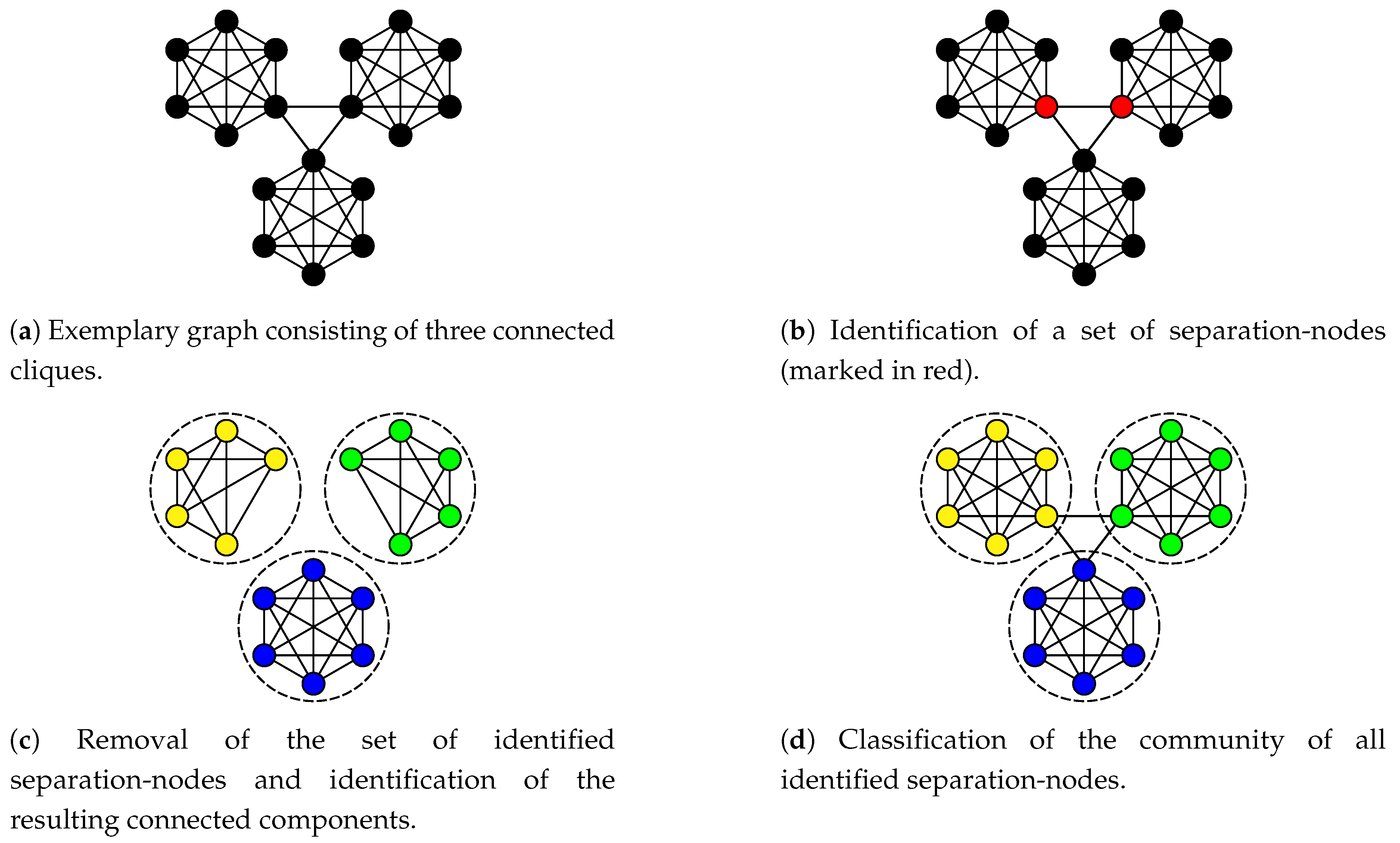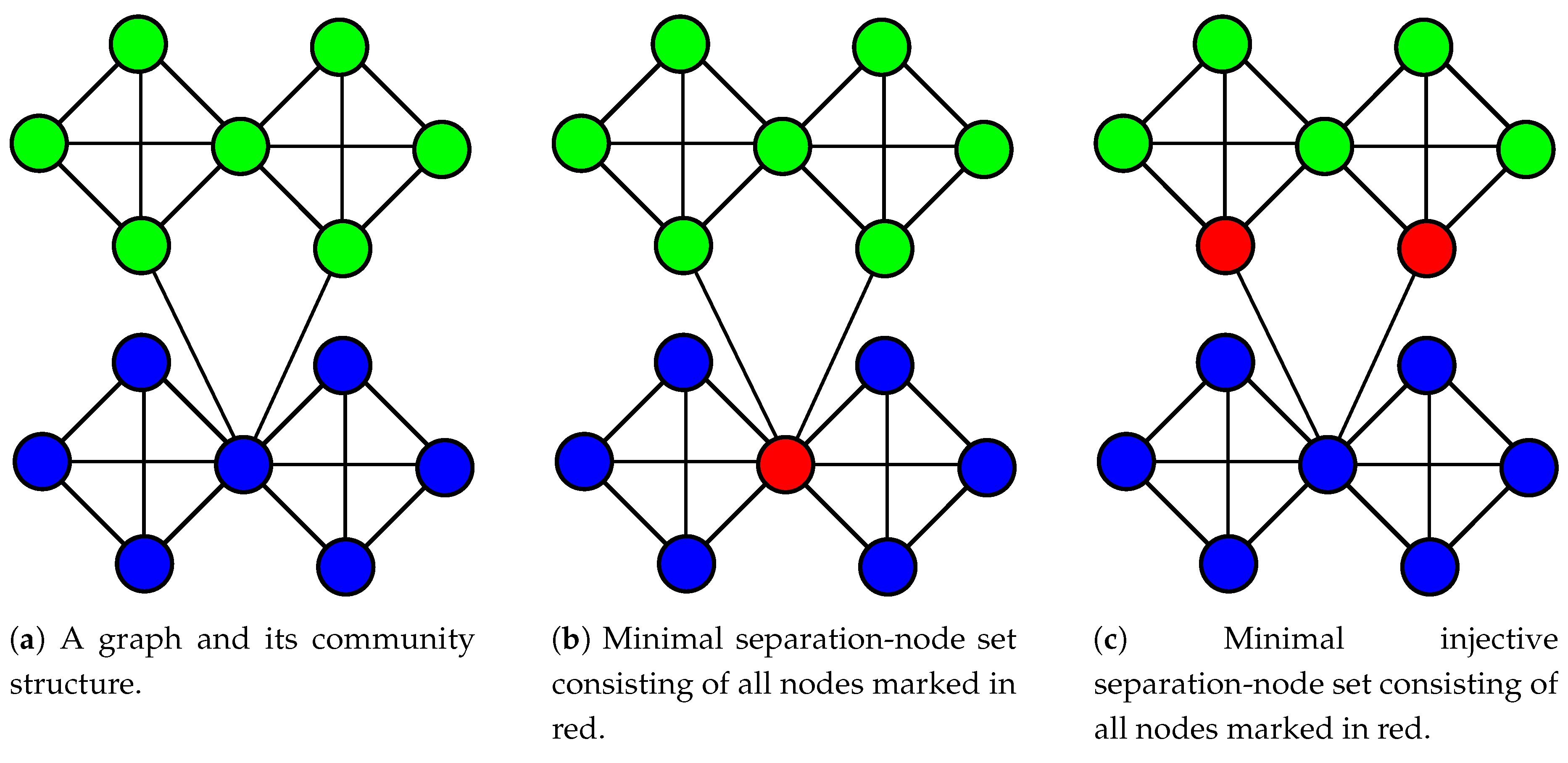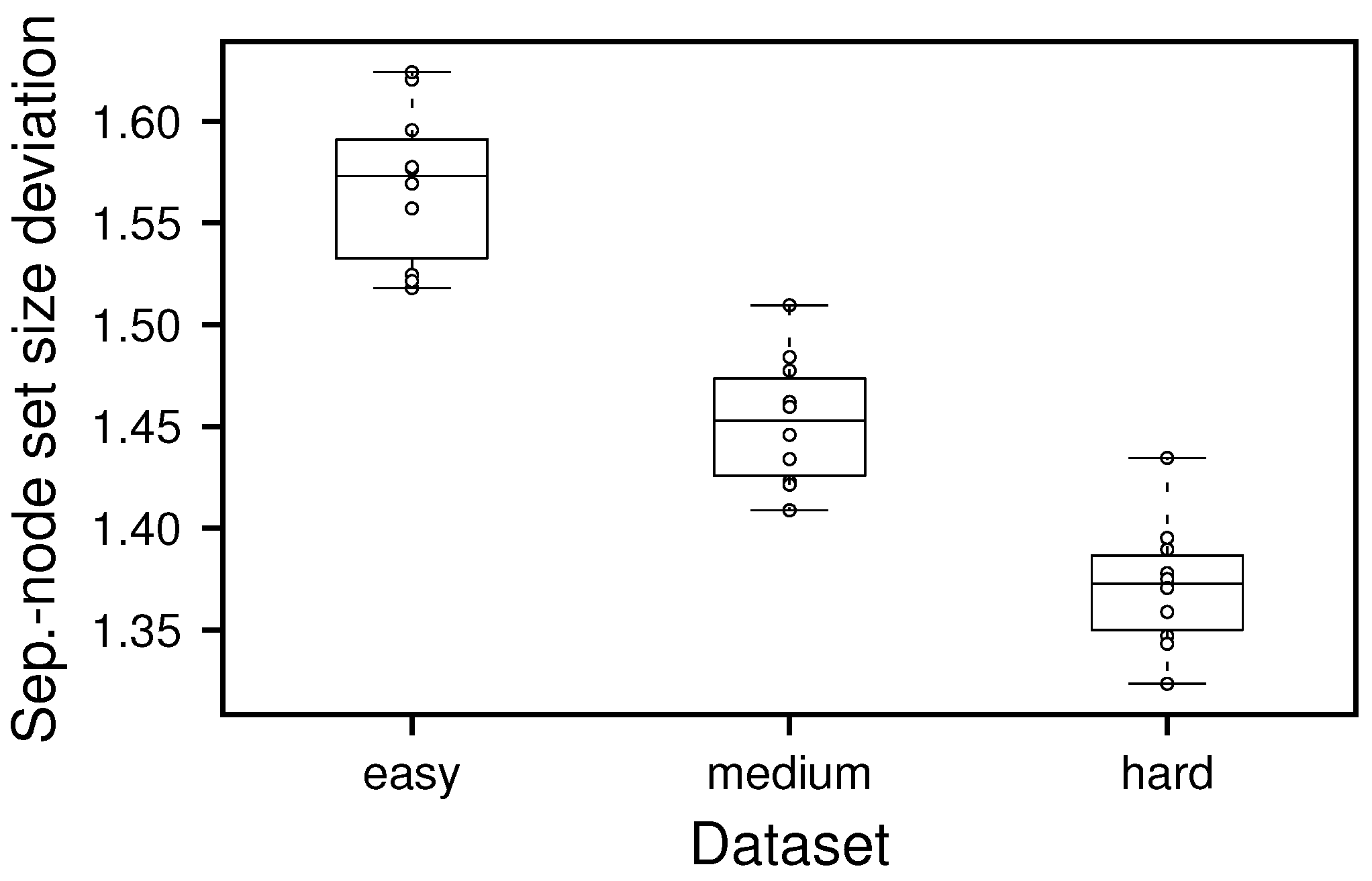Submitted:
01 July 2023
Posted:
03 July 2023
You are already at the latest version
Abstract
Keywords:
1. Introduction
2. Related Work
- Randomly split the given graph into two equally sized partitions and delete all edges inside the partitions to yield a bipartite graph
-
Find subsets and such that and where is the solution to the quadratic program given by:Here, denotes the link density of two disjoint sets , given by and represents the number of edges connecting and .
- Identify to be a community and repeat steps 1) and 2) for the subgraph induced on G by .
3. Concept
3.1. Separation-node sets
- (1)
- identifying a set of nodes separating communities and thus revealing the fundamental community structure (Section 3.2 and Section 3.3)
- (2)
- classifying the community of each separation-node to finalize the community detection (Section 3.4)
3.2. Modularity-based separation-edge estimation
- , iff less connectivity between and was to be expected, indicating that and likely belong to the same community
- , iff more connectivity between and was to be expected, indicating that and likely belong to different communities
3.3. Edge neighborhood connectivity based separation-edge estimation
- (1)
- Consider connections between r-neighborhoods with radius
- (2)
- Also consider paths of length 2
3.4. Assigning the separation-nodes to communities
- (1)
- Count the number of edges to every know community for each separation-node.
- (2)
- Assign the node with the most edges to a single community to that community.
- (3)
- Update the counts for every neighboring separation-node.
- (4)
- Repeat steps two and three until every separation-node is properly assigned to a community.
4. Evaluation
- (1)
- the assignment of separation-nodes to their communities is computationally easy, given a good enough estimator
- (2)
- neighborhood connectivity allows for proof of concept results
5. Conclusion
Author Contributions
Funding
Data Availability Statement
Conflicts of Interest
Appendix A. Remaining Proofs
Appendix A.1. Proving theorem IV.1
- 1.
- and the separation-node set is smaller than S.
- 2.
- and the separation-node set is much smaller than S.
- 1.
- .
- 2.
- .
Appendix A.2. Constructing penalty terms for the in- and surjectivity constraints
References
- Bondy, J.A.; Murty, U.S.R. Graph Theory with Applications; Elsevier: New York, 1976. [Google Scholar]
- Mashaghi, A.R.; Ramezanpour, A.; Karimipour, V. Investigation of a protein complex network. Eur. Phys. J. B - Condens. Matter Complex Syst. 2004, 41, 113–121. [Google Scholar] [CrossRef]
- Shah, P.; Ashourvan, A.; Mikhail, F.; Pines, A.; Kini, L.; Oechsel, K.; Das, S.R.; Stein, J.M.; Shinohara, R.T.; Bassett, D.S.; Litt, B.; Davis, K.A. Characterizing the role of the structural connectome in seizure dynamics. Brain 2019, 142, 1955–1972. [Google Scholar] [CrossRef]
- Fortunato, S. Community detection in graphs. Physics Reports 2010, 486, 75–174. [Google Scholar] [CrossRef]
- Girvan, M.; Newman, M.E.J. Community structure in social and biological networks. Proceedings of the National Academy of Sciences 2002, 99, 7821–7826. [Google Scholar] [CrossRef] [PubMed]
- Fani, H.; Bagheri, E. Community detection in social networks. Encyclopedia with Semantic Computing and Robotic Intelligence 2017, 01, 1630001. [Google Scholar] [CrossRef]
- Nadakuditi, R.R.; Newman, M.E.J. Graph Spectra and the Detectability of Community Structure in Networks. Phys. Rev. Lett. 2012, 108, 188701. [Google Scholar] [CrossRef]
- Brandes, U.; Delling, D.; Gaertler, M.; Goerke, R.; Hoefer, M.; Nikoloski, Z.; Wagner, D. Maximizing Modularity is hard, 2006. [CrossRef]
- Decelle, A.; Krzakala, F.; Moore, C.; Zdeborová, L. Inference and Phase Transitions in the Detection of Modules in Sparse Networks. Phys. Rev. Lett. 2011, 107, 065701. [Google Scholar] [CrossRef]
- Newman, M.E.J. Equivalence between modularity optimization and maximum likelihood methods for community detection. Phys. Rev. E 2016, 94, 052315. [Google Scholar] [CrossRef]
- Arute, F.; Arya, K.; Babbush, R.; Bacon, D.; Bardin, J.C.; Barends, R.; Biswas, R.; Boixo, S.; Brandao, F.G.S.L.; Buell, D.A.; Burkett, B.; Chen, Y.; Chen, Z.; Chiaro, B.; Collins, R.; Courtney, W.; Dunsworth, A.; Farhi, E.; Foxen, B.; Fowler, A.; Gidney, C.; Giustina, M.; Graff, R.; Guerin, K.; Habegger, S.; Harrigan, M.P.; Hartmann, M.J.; Ho, A.; Hoffmann, M.; Huang, T.; Humble, T.S.; Isakov, S.V.; Jeffrey, E.; Jiang, Z.; Kafri, D.; Kechedzhi, K.; Kelly, J.; Klimov, P.V.; Knysh, S.; Korotkov, A.; Kostritsa, F.; Landhuis, D.; Lindmark, M.; Lucero, E.; Lyakh, D.; Mandra, S.; McClean, J.R.; McEwen, M.; Megrant, A.; Mi, X.; Michielsen, K.; Mohseni, M.; Mutus, J.; Naaman, O.; Neeley, M.; Neill, C.; Niu, M.Y.; Ostby, E.; Petukhov, A.; Platt, J.C.; Quintana, C.; Rieffel, E.G.; Roushan, P.; Rubin, N.C.; Sank, D.; Satzinger, K.J.; Smelyanskiy, V.; Sung, K.J.; Trevithick, M.D.; Vainsencher, A.; Villalonga, B.; White, T.; Yao, Z.J.; Yeh, P.; Zalcman, A.; Neven, H.; Martinis, J.M. Quantum supremacy using a programmable superconducting processor. Nature 2019, 574, 505–510. [Google Scholar] [CrossRef]
- Shaydulin, R.; Ushijima-Mwesigwa, H.; Safro, I.; Mniszewski, S.; Alexeev, Y. Network Community Detection on Small Quantum Computers. Advanced Quantum Technologies 2019, 2, 1900029. [Google Scholar] [CrossRef]
- Denchev, V.S.; Boixo, S.; Isakov, S.V.; Ding, N.; Babbush, R.; Smelyanskiy, V.; Martinis, J.; Neven, H. What is the Computational Value of Finite-Range Tunneling? Phys. Rev. X 2016, 6, 031015. [Google Scholar] [CrossRef]
- Albash, T.; Lidar, D.A. Demonstration of a Scaling Advantage for a Quantum Annealer over Simulated Annealing. Phys. Rev. X 2018, 8, 031016. [Google Scholar] [CrossRef]
- Grover, L.K. A fast quantum mechanical algorithm for database search. Proceedings of the twenty-eighth annual ACM symposium on Theory of computing - STOC ’96; Philadelphia, Pennsylvania, USA: Association for Computing Machinery, 1996; pp. 212–219. [Google Scholar] [CrossRef]
- Shor, P.W. Polynomial-Time Algorithms for Prime Factorization and Discrete Logarithms on a Quantum Computer. SIAM Journal on Computing 1997, 26, 1484–1509. [Google Scholar] [CrossRef]
- Lloyd, S. Universal Quantum Simulators. Science 1996, 273, 1073–1078. [Google Scholar] [CrossRef]
- Ushijima-Mwesigwa, H.; Negre, C.F.A.; Mniszewski, S.M. Graph Partitioning Using Quantum Annealing on the D-Wave System. Proceedings of the Second International Workshop on Post Moores Era Supercomputing; Association for Computing Machinery: New York, NY, USA, 2017; PMES’17, p. 22–29. [Google Scholar] [CrossRef]
- Newman, M.E.J.; Girvan, M. Finding and evaluating community structure in networks. Phys. Rev. E 2004, 69, 026113. [Google Scholar] [CrossRef] [PubMed]
- Kadowaki, T.; Nishimori, H. Quantum annealing in the transverse Ising model. Phys. Rev. E 1998, 58, 5355–5363. [Google Scholar] [CrossRef]
- Preskill, J. Quantum Computing in the NISQ era and beyond. Quantum 2018, 2, 79. [Google Scholar] [CrossRef]
- Dalyac, C.; Henriet, L.; Jeandel, E.; Lechner, W.; Perdrix, S.; Porcheron, M.; Veshchezerova, M. Qualifying quantum approaches for hard industrial optimization problems. A case study in the field of smart-charging of electric vehicles. EPJ Quantum Technol. 2021, 8, 12. [Google Scholar] [CrossRef]
- Akbar, S.; Saritha, S.K. Towards quantum computing based community detection. Computer Science Review 2020, 38, 100313. [Google Scholar] [CrossRef]
- Zahedinejad, E.; Crawford, D.; Adolphs, C.; Oberoi, J.S. Multiple Global Community Detection in Signed Graphs. Proceedings of the Future Technologies Conference (FTC) 2019; Arai, K., Bhatia, R., Kapoor, S., Eds.; Springer International Publishing: Cham, 2020; pp. 688–707. [Google Scholar]
- Sedghpour, A.S.; Nikanjam, A. Overlapping Community Detection in Social Networks Using a Quantum-Based Genetic Algorithm. Proceedings of the Genetic and Evolutionary Computation Conference Companion; Association for Computing Machinery: New York, NY, USA, 2017; GECCO ’17, p. 197–198. [Google Scholar] [CrossRef]
- Mukai, K.; Hatano, N. Discrete-time quantum walk on complex networks for community detection. Phys. Rev. Res. 2020, 2, 023378. [Google Scholar] [CrossRef]
- Reittu, H.; Kotovirta, V.; Leskelä, L.; Rummukainen, H.; Räty, T. Towards analyzing large graphs with quantum annealing. 2019 IEEE International Conference on Big Data (Big Data), 2019, pp. 2457–2464. [CrossRef]
- Chan, E.Y.K.; Yeung, D.Y. A Convex Formulation of Modularity Maximization for Community Detection. In Proceedings of the Twenty-Second International Joint Conference on Artificial Intelligence - Volume Volume Three. AAAI Press, 2011, IJCAI’11, p. 2218–2225.
- Chen, Y.; Li, X.; Xu, J. CONVEXIFIED MODULARITY MAXIMIZATION FOR DEGREE-CORRECTED STOCHASTIC BLOCK MODELS. The Annals of Statistics 2018, 46, 1573–1602. [Google Scholar] [CrossRef]
- Abdalla, P.; Bandeira, A.S. Community detection with a subsampled semidefinite program. Sampl. Theory, Signal Process. Data Anal. 2022, 20, 6. [Google Scholar] [CrossRef]
- Li, W. Visualizing network communities with a semi-definite programming method. Information Sciences 2015, 321, 1–13. Security and privacy information technologies and applications for wireless pervasive computing environments. [CrossRef]
- Brandes, U. A faster algorithm for betweenness centrality. The Journal of Mathematical Sociology 2001, 25, 163–177. [Google Scholar] [CrossRef]
- Negre, C.F.; Ushijima-Mwesigwa, H.; Mniszewski, S.M. Detecting multiple communities using quantum annealing on the D-Wave system. PLoS ONE 2020, 15, 1901–09756. [Google Scholar] [CrossRef]
- Chapuis, G.; Djidjev, H.; Hahn, G.; Rizk, G. Finding Maximum Cliques on the D-Wave Quantum Annealer. J. Signal Process. Syst. 2019, 91, 363–377. [Google Scholar] [CrossRef]
- Rosenberg, I.G. Reduction of bivalent maximization to the quadratic case. Cahiers du Centre d’etudes de recherche operationnelle 1975, 17, 71–74. [Google Scholar]
- Thorndike, R.L. Who belongs in the family? Psychometrika 1953, 18, 267–276. [Google Scholar] [CrossRef]
- Amin, M.H.; Andriyash, E.; Rolfe, J.; Kulchytskyy, B.; Melko, R. Quantum Boltzmann Machine. Phys. Rev. X 2018, 8, 021050. [Google Scholar] [CrossRef]
- Holland, P.W.; Laskey, K.B.; Leinhardt, S. Stochastic blockmodels: First steps. Social Networks 1983, 5, 109–137. [Google Scholar] [CrossRef]
- Fred, A.L.N.; Jain, A.K. Robust data clustering. 2003 IEEE Computer Society Conference on Computer Vision and Pattern Recognition, 2003. Proceedings. 2003, 2, II. [Google Scholar] [CrossRef]
- Kuncheva, L.; Hadjitodorov, S. Using diversity in cluster ensembles. 2004 IEEE International Conference on Systems, Man and Cybernetics (IEEE Cat. No.04CH37583), 2004, Vol. 2, pp. 1214–1219 vol.2. [CrossRef]
- Danon, L.; Díaz-Guilera, A.; Duch, J.; Arenas, A. Comparing community structure identification. Journal of Statistical Mechanics: Theory and Experiment 2005, 2005, P09008. [Google Scholar] [CrossRef]
- Zachary, W.W. An Information Flow Model for Conflict and Fission in Small Groups. Journal of Anthropological Research 1977, 33, 452–473. [Google Scholar] [CrossRef]
- Lusseau, D.; Schneider, K.; Boisseau, O.J.; Haase, P.; Slooten, E.; Dawson, S.M. The bottlenose dolphin community of Doubtful Sound features a large proportion of long-lasting associations. Behavioral Ecology and Sociobiology 2003, 54, 396–405. [Google Scholar] [CrossRef]
- Knuth, D.E. The Stanford GraphBase: A Platform for Combinatorial Algorithms. Proceedings of the Fourth Annual ACM-SIAM Symposium on Discrete Algorithms; Society for Industrial and Applied Mathematics: USA, 1993; SODA ’93, p. 41–43. [Google Scholar]
- Palla, G.; Derényi, I.; Farkas, I.; Vicsek, T. Uncovering the overlapping community structure of complex networks in nature and society. Nature 2005, 435, 814–818. [Google Scholar] [CrossRef]
- Newman, M.E.J. Modularity and community structure in networks. Proceedings of the National Academy of Sciences 2006, 103, 8577–8582. [Google Scholar] [CrossRef]
- Li, Y.; Li, W.; Tan, Y.; Liu, F.; Cao, Y.; Lee, K.Y. Hierarchical Decomposition for Betweenness Centrality Measure of Complex Networks. Sci. Rep. 2017, 7, 46491. [Google Scholar] [CrossRef]
- Sedgewick, R. Algorithms in c, Part 5: Graph Algorithms, Third Edition; third ed.; Addison-Wesley Professional, 2001. [Google Scholar]









Disclaimer/Publisher’s Note: The statements, opinions and data contained in all publications are solely those of the individual author(s) and contributor(s) and not of MDPI and/or the editor(s). MDPI and/or the editor(s) disclaim responsibility for any injury to people or property resulting from any ideas, methods, instructions or products referred to in the content. |
© 2023 by the authors. Licensee MDPI, Basel, Switzerland. This article is an open access article distributed under the terms and conditions of the Creative Commons Attribution (CC BY) license (http://creativecommons.org/licenses/by/4.0/).




